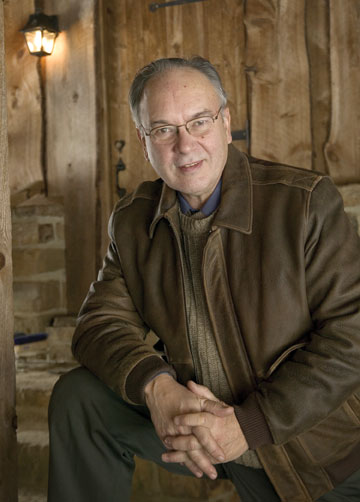Why
He Says “I’m Retiring”
The Editor of CARNEGIE magazine
retires after 31 years at
Carnegie Museums of Pittsburgh.
By
R.J. Gangewere

PHOTO: TERRY CLARK
This is a time for arithmetic. I will be 68
years old in November, and since June 1973 I
have edited CARNEGIE magazine ten times
a year until 1980, and six times a year since
then, amounting to a total of 202 issues. It’s
been a wonderful ride.
I have worked with and/or under four Carnegie
Institute presidents, four Museum of Art Directors,
six Natural History Directors, three Carnegie
Library Directors, three Carnegie Science Center
Directors, three Andy Warhol Museum Directors,
eight directors of my own department, and more
curators than I will list (heaven bless them
all). My three decades of interviews and stories
are faithfully stored in bound volumes of CARNEGIE
magazine.
Then there was the big event in September 2003,
when my wife and I were driving in our Subaru
doing the speed limit in the right hand lane
on Interstate 80 near Brookville, coming home
from vacation, when we were hit from behind
by another car. Our car bounced into the Jersey
barrier, rebounded left into the passing lane,
and was hit again Our car was totaled, but we
stepped out of it unscathed, knowing forever
that we could have been dead in five seconds
while listening contentedly to New Age music
on a CD. Does this make you think?
Do you believe in doing things “someday”?
I decided that, for me, someday was today. “Freedom
has always been an expensive thing,” said
Martin Luther King, but I want it now, with
time to do the things I want.
When I look back, I’ve had a great professional
life. After my Ph.D. in English, I taught at
four universities in a career spanning 42 years,
most of it as a faculty member at Carnegie Mellon
while also being editor of CARNEGIE
magazine. I lived and worked in Egypt as a young
assistant professor. I have written or edited
books on the environment and American history,
Pittsburgh bridges, and foxhunting in western
Pennsylvania, among other things. I have learned
from museum scientists, art historians, librarians,
students, and volunteers—many of them
my close friends.
Now I can pursue my next enterprise: writing
and publishing the history of Carnegie Institute
and Carnegie Library of Pittsburgh for the University
of Pittsburgh Press.
What better finale could a writer want than
the chance to summarize his thoughts about the
great museums he has explored and been fascinated
by for three decades? I now get to tell the
stories. I can tell about Andrew Carnegie sitting
on a log in Cresson, Pennsylvania, 130 years
ago, when he first told minister William Holland
he wanted to do something special for Pittsburgh,
like build a library. And then I can tell the
story of that library. I can tell about the
Czar’s courtier—Andrey Avinoff—who
fled Russia after the revolution to bring his
artistic and scientific skills to Pittsburgh
as director of Carnegie Museum of Natural History.
I can tell how Museum of Art Director Gordon
Bailey Washburn introduced abstract art to Pittsburgh
in Carnegie Internationals and trained
his successor, the man with the famous “eye”
for installing art, Leon A. Arkus. And then
there are the stories about the Bellefield Boiler
Plant, the Music Hall, the Carnegie Science
Center, and The Andy Warhol Museum. And the
stories about administrators, Pittsburgh philanthropists,
and civic leaders who steadfastly supported
the museums and library through the decades.
All this happens against the social and economic
backdrop of the 20th century, as museums themselves
change, and new techniques and directions in
art, science, music, and literature transform
Mr. Carnegie’s Victorian Palace of Culture,
with its economies of scale and administration,
into a modern non-profit corporation. It’s
a very American story with no simple parallel
in the larger world of museums. I can’t
wait to tell it.
For those underemployed writers who reach for
their resumés when they hear an editor
is vacating a post, I have to say that they
should save the postage. Betsy Momich will assume
the role of editor and Kim Tarquinio will serve
as managing editor.
So, “I’m retiring” as an
editor. But I am not retiring as a writer and
historian. I believe my best is yet to come—something
that will influence future generations of people
who care about Carnegie Institute and Library.
I’m working on it.
Back to Contents |